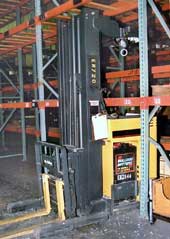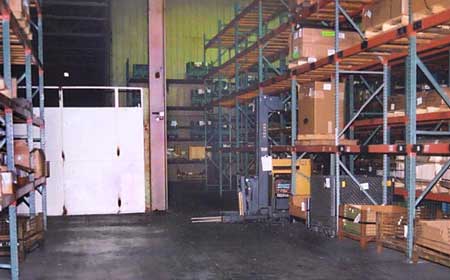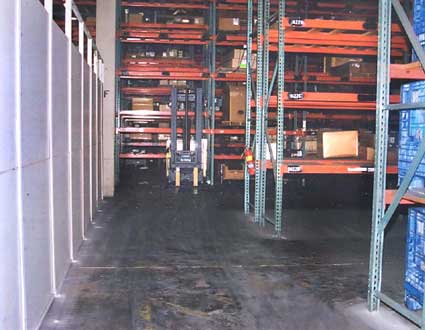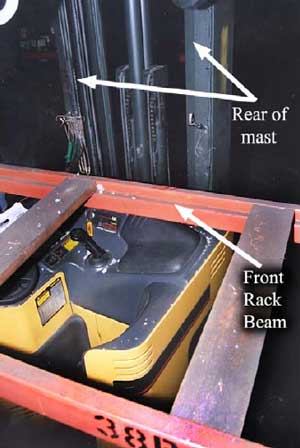Warehouse Forklift Operator Crushed Against Rack Beam
Iowa Case Report: 03IA057
Report Date: August 24, 2004
 |
|
Photo 1 – Left-front view of the forklift, positioned as it was found under the empty metal rack beam.
|
Summary
During the fall of 2003, a 35-year-old warehouse worker was killed when his forklift slammed into the edge of an empty horizontal metal rack beam. He was operating a standup reach forklift, which normally has the operator’s left side facing the rear of the machine. The man was driving his forklift in reverse down an alleyway when he crashed into the rack beam, which was in a T-intersection in the warehouse. This brand of forklift had an overhead guard to protect from falling objects, but had no protection from horizontal components entering the rear of the operator’s station. There was nothing on the pallet deck to cushion the impact, therefore, the man was crushed between the rack beam and the rear of the forklift mast, and died from traumatic asphyxia. There was no evidence the man was braking at the time, therefore his machine was likely traveling at 7 mph, its maximum speed.
The man was an experienced worker and had no reason to be in a hurry at that time in his work shift. It is assumed he simply got distracted and was unaware he had entered the T-intersection. Another worker in the warehouse heard the sound of the crash and found the victim crushed in the machine. He was unable to move the forklift, then immediately called 911. The victim was taken to a local hospital, where he was pronounced dead.
Recommendations based on our investigation are as follows:
- Operators of industrial forklifts should always be diligent to face the direction of travel, mindful of their exposure to warehouse hazards that could enter their work station.
- Warehouse managers should examine rack beam heights throughout their facilities to see if hazardous areas exist.
- Manufacturers of standup reach forklifts should include vertical framing or posts at the rear corners of their machines, from the operator’s console to the overhead guard, to protect the operator from horizontal components entering the operator’s station.
- Lease Companies or warehouse facilities with an inventory of unprotected standup / narrow-aisle forklifts should consider options to replace or retrofit their equipment.
Introduction
In October, 2003, a 35-yearold male forklift operator was killed when his machine crashed into a horizontal rack beam in a warehouse. The Iowa FACE program was notified of this incident a few days later, and began an investigation, gathering information and photographs from local police, newspapers, the medical examiner, company spokesmen, and forklift manufacturers.
The employer is a warehousing / distribution company, which had been in business for the past six years, handling parts and supplies for many types of industrial and agricultural machines. It had two warehouse locations and employed about 75 employees. The victim had worked at the company since it began, and was considered a good and dependable worker. He operated a stand-up reach forklift (commonly called a narrow-aisle forklift) in the warehouse area, his job title being parts picker. There were six other employees who operated these same machines, and another seven workers who drove sit-down forklifts. The company had rotating work shifts, and the victim’s work hours were normally from 6:00 pm to 2:30 am.
The company had a comprehensive safety program with written policies and regular safety meetings held at least once per month. These covered a variety of safety issues, which employees were required to attend. All machine operators were certified, with annual re-certification by company-trained instructors. Company policy states that workers seen racing forklifts or otherwise operating them in an unsafe manner will be disciplined or fired. This was the first fatality for this company.
 |
|
Photo 2 – Wide view from the left of the forklift, showing the T-intersection.
|
Investigation
This warehouse facility had 111,000 sq. ft. of storage space, and processed about 600 orders per day. Two employees usually worked per shift operating the stand-up reach forklifts as parts-pickers, while other employees sorted and packaged the parts on pallets to be loaded onto trucks for shipment to machinery dealers in the region. During the evening shift, orders were only assembled, to be loaded and trucked out the following morning.
The stand-up reach forklifts were leased equipment and were battery operated units containing electric and hydraulic motor components. The machine the victim was using had been at the company for only six months, and was in excellent condition. It was a Caterpillar, model NRR45, which had a lift capacity of 4,500 lbs. and a maximum elevated height of 300 inches. This 36-volt machine is classified as a Class II, Lift Code 3, standup reach powered industrial truck.(1) By convention, the front of this machine is the load-bearing end, and on this model, the operator stands facing the left side of the machine. (see Photo 4).
 |
|
Photo 3 – View from the front of the forklift, showing the aisle ends and the wall to the side.
|
There were two forklift operators working on the night the incident occurred, the only two employees in the building. Employees were required to work in pairs for safety and logistical reasons, with each worker in opposite ends of the warehouse. The two forklift operators would occasionally overlap their work areas and had to be aware of the other operator’s position. As parts picker, the victim assembled multiple packages from various pallet racks to be loaded the next morning into trucks. The victim had started his shift at 6:00 pm., and had no known reason to be in a hurry. He was in the middle of assembling an order, returning empty from the docking area. He was driving in reverse down an aisle which had aisle ends to the left of his machine and a white wall to the right side of the machine (see Photo 3).
Behind the forklift, at the end of the T-intersection was an open and empty metal rack beam, the lower edge of the beam at a height of 54 inches. The victim was driving with the forks down when he slammed into the empty rack beam, which instantly crushed him against the rear of the mast section of the machine, causing fatal internal injuries (see Photo 4). There was no indication that the victim was in the midst of a turn or was braking when he crashed into the beam, therefore, it is assumed he was simply distracted while driving or not watching where he was going. The height of the machine console was 52 inches, which perfectly fit underneath the empty beam. The forklift did not have any vertical corners / posts at the rear of the machine or other means to prevent a horizontal shelf or rack beam from entering the operator’s work area.
The other employee in the building heard the load sound of the crash and rushed to find his coworker crushed between the metal beam and the front of the operator’s compartment, his body slumped over the beam itself. He shouted to his friend with no response, then, tried unsuccessfully to move the forklift away from the beam. He immediately phoned 911 and returned to aid his friend. The victim was taken to a local hospital, where he was pronounced dead.
The co-worker had talked to the victim just 30 minutes prior to the incident, and had not noticed anything unusual about his demeanor or mood. They were friends, and the victim was known to be a hard-working employee, and had an exemplary record. The involved forklift was tested numerous times and found to be in normal working condition, including its brakes.
 |
|
Photo 4 – View from behind the rack beam showing the operator’s work area, machine controls on the console, and the unprotected rear corner of the machine.
|
The lights in the area of the crash were all working properly, and the floor was not littered, wet, or defective, but was smooth concrete (see Photo 3). Paint markings on the floor were very faint and worn, but the markings were for pedestrian traffic, and not for machine operators. There were numerous similar T-intersections in the warehouse area, and many intersections were equipped with convex mirrors. This forklift had a top speed of 7 mph (11 km/h), however, it is not known how fast the machine was traveling at the time of impact.
In this warehouse, the height of rack beams varies according to product needs. In most cases the height of the first beam was 36-48 inches, but in this area of the facility, the bottom edge of the first rack beam was at 54 inches. The height of the forklift operator station was 52 inches; therefore it easily slipped under the rack beam (see Photo 4). If the pallet decks had been full of merchandise, it is likely the machine itself or the overhead guard would have hit merchandise on the deck, cushioning the impact and throwing the operator against the beam and anything on the pallet. At 7 mph. serious injury would be possible, but fatal internal injuries would likely not occur. Since this incident the company has removed the rack beam at this T-intersection, since it was the only one in the area with rack beams set at 54 inches. All other T-intersections had racks with lower beam heights.
An identical crush hazard may exist in every narrow aisle in this warehouse, for when the forklift is positioned perpendicular to a rack beam to raise or lower a load, the operator could pull too far in reverse and drive under the rack beam on the opposite side of the aisle. These machines are termed “narrow aisle” reach trucks, designed for use in tight quarters, and this model has a turning radius of approximately eight feet. The narrower the aisle, the greater likelihood of this type of injury occurring again, however, in this scenario, the machine would likely be traveling at a much slower speed.
Cause of Death
The cause of death was listed as, “traumatic asphyxia due to chest compression by a forklift.” An autopsy revealed no presence of alcohol or drugs.
Recommendations/Discussion
Recommendation #1: Operators of industrial forklifts should always be diligent to face the direction of travel, mindful of their exposure to warehouse hazards that could enter their work station.
Discussion: In this warehouse, most of the rack beams were at a height lower than the forklift machine console, where a collision with a beam would impact the body of the forklift, and not directly endanger the life of the operator. Perhaps the victim was unaware of higher rack beams in the facility that could enter his work station and cause injury. Therefore, it is imperative that workers become aware of this hazard, and be on the alert for hazardous areas where they work, especially at T-intersections where machine operators may be braking, making turns, watching mirrors, etc. Workers should always be mindful of their location within a facility, especially if they are operating a machine which does not have vertical posts to protect from horizontal hazards like rack beams.
Recommendation #2: Warehouse managers should examine rack beam heights throughout their facilities to see if hazardous areas exist.
Discussion: This case brings to light a hazard that probably exists in many warehouses. Some narrow-aisle forklifts may have vertical posts on the rear of the machine, which will protect the operator from horizontal hazards, and other machines may not. Many rack beams will be shorter than the height of the machine console, but some may be taller. Some facilities may handle piping, lumber, or other long merchandise, that, if approached on end, would be hazardous to any type of industrial truck. There may be warehouse areas that are hazardous to certain machines, and not others, therefore, it would be prudent to check the entire facility for potential problems. It is important to make workers aware of these hazards, however, engineering controls are necessary to prevent this type of injury from occurring again.
Recommendation #3: Manufacturers of standup reach forklifts should include vertical posts or framing at the rear corners of their machines, from the operator’s console to the overhead guard, to protect the operator from horizontal components entering the operator’s station.
Discussion: There are numerous types of forklifts and material handlers from this manufacturer, and several others, in many different classifications, for specific uses, etc. Some of these machines offer no protection from a horizontal rack beam entering the rear of the operator’s station. However, several manufacturers of standup reach forklifts do provide vertical corners / posts to the rear of their machines, either as standard equipment, or as a purchase option. The manufacturer of the forklift in this case (Caterpillar) does provide rear vertical posts as a purchase option. These vertical posts provide significant protection from a similar fatal event occurring in another warehouse. With vertical elements installed, a collision with a rack beam at 7 mph. would likely cause serious injury, but significantly reduce the likelihood of rack beams entering the operator’s station. Vertical corners would not compromise the operation of the machine to any degree, and would still allow workers to easily move in and out of the machine. However, these corners cannot protect the operator from all objects entering the operator’s work station.
Recommendation #4: Lease Companies or warehouse facilities with an inventory of unprotected standup / narrow-aisle forklifts should consider options to replace or retrofit their equipment.
Discussion: In most warehouse environments, rack beam height is a variable thing, therefore, to improve safety, it makes sense to modify forklift equipment, rather than modify the height of rack beams throughout a facility. Some companies have invested heavily in similar narrow-aisle reach forklifts, which do not provide protection from horizontal hazards entering the rear of the operator’s area. It may be impractical to abandon these machines, nor cost effective to buy a new fleet of safer machines. The best option is to check with the manufacturer to determine if vertical rear posts can be purchased for their machines, or possibly through an aftermarket company. Other sensible options are to replace old equipment with safer models as budgets allow, or if machines are leased, switch to a different company or request a different brand / model of forklift. The least desirable alternative may be to retrofit forklifts using metal pipes or angle irons. This would be easy to accomplish, and provide significant protection at slow speed, yet such improvements would not be engineered or tested.
Reference
Industrial Truck Association, 1750 K Street NW, Suite 460, Washington, DC 20006
https://www.indtrk.org/ (Link updated 9/25/2008) (see Member Products).
Iowa FACE Program
FACE is an occupational fatality investigation and surveillance program of the National Institute for Occupational Safety and Health (NIOSH). In the state of Iowa, The University of Iowa, in conjunction with the Iowa Department of Public Health carries out the FACE program. The NIOSH head office in Morgantown, West Virginia, carries out an intramural FACE program and funds state based programs in Alaska, California, Iowa, Kentucky, Massachusetts, Michigan, Minnesota, Nebraska, New Jersey, New York, Oklahoma, Oregon, Washington, West Virginia, and Wisconsin.
The purpose of FACE is to identify all occupational fatalities in the participating states, conduct in depth investigations on specific types of fatalities, and make recommendations regarding prevention. NIOSH collects this information nationally and publishes reports and Alerts, which are disseminated widely to the involved industries. NIOSH FACE publications are available from the NIOSH Distribution Center (1-800-35NIOSH).
Iowa FACE publishes case reports, one page Warnings, and articles in trade journals. Most of this information is posted on our web site listed below. Copies of the reports and Warnings are available by contacting our offices in Iowa City, IA.
The Iowa FACE team consists of the following from the University of Iowa: Craig Zwerling, MD, PhD, MPH, Principal Investigator; Wayne Johnson, MD, Chief Investigator; John Lundell, MA, Coordinator; Risto Rautiainen, PhD, Co-Investigator, and John Kraemer, PA. from the Office of The State Medical Examiner.
To contact Iowa State FACE program personnel regarding State-based FACE reports, please use information listed on the Contact Sheet on the NIOSH FACE web site Please contact In-house FACE program personnel regarding In-house FACE reports and to gain assistance when State-FACE program personnel cannot be reached.

